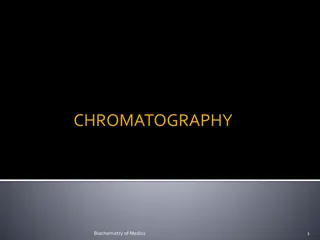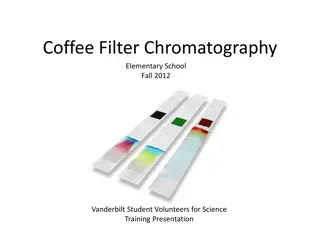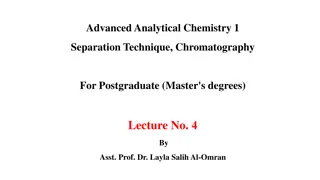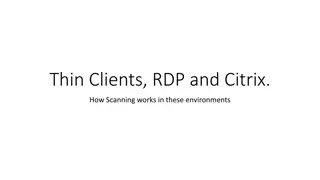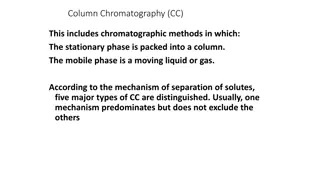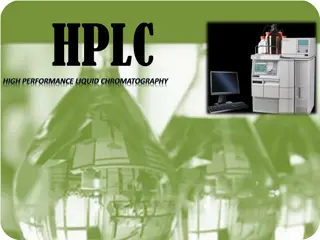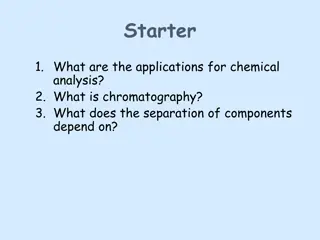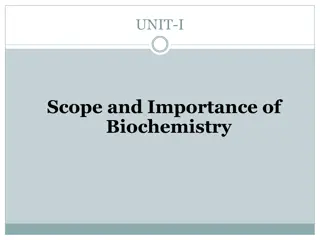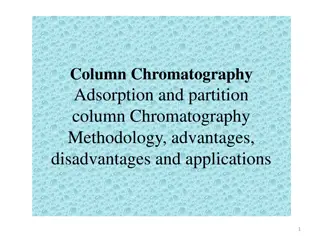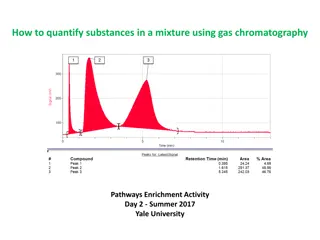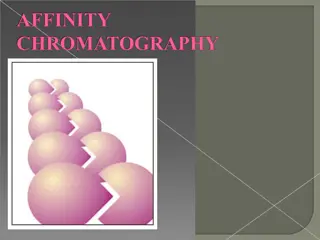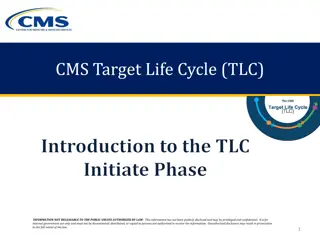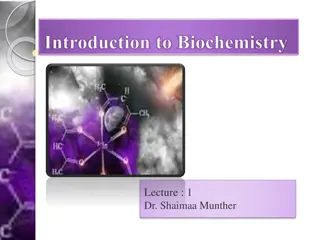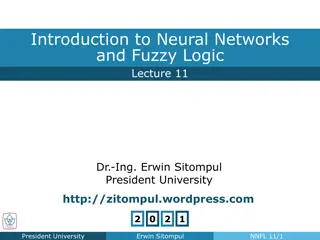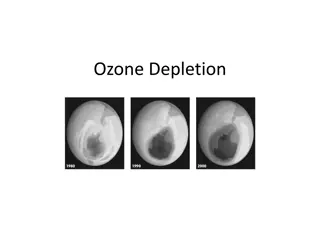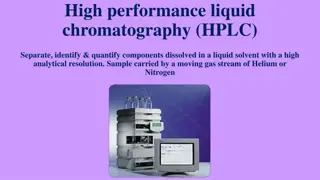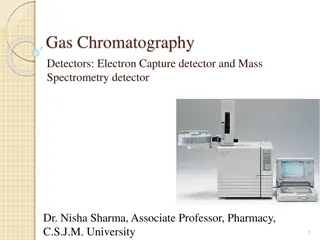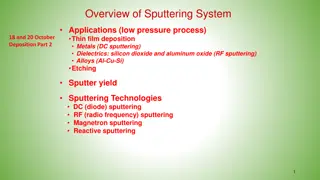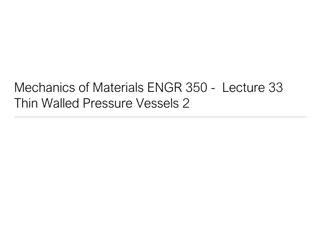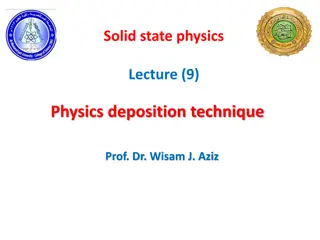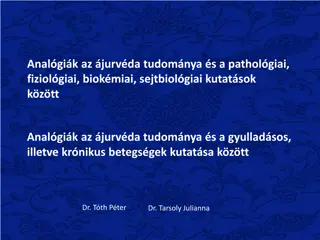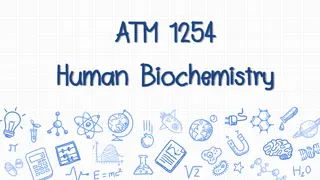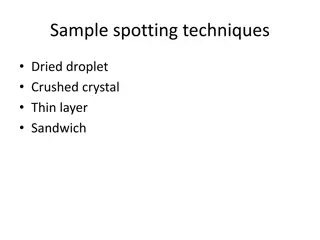Understanding Paper and Thin Layer Chromatography (TLC) in Biochemistry
Chromatography techniques are used in laboratories to separate and identify components of mixtures. Paper chromatography is a type where a developing solution travels up a filter paper, separating compounds based on their affinity to the stationary phase. Thin Layer Chromatography (TLC) is a similar method but uses a thin layer of adsorbent material on a glass plate. This process helps diagnose conditions like Phenylketonuria and Cystinuria by analyzing urine samples. Different compounds move at varying rates due to solubility and attraction differences. Ascending and descending paper chromatography methods are explained, showcasing the principles behind these separations.
Download Presentation

Please find below an Image/Link to download the presentation.
The content on the website is provided AS IS for your information and personal use only. It may not be sold, licensed, or shared on other websites without obtaining consent from the author. Download presentation by click this link. If you encounter any issues during the download, it is possible that the publisher has removed the file from their server.
E N D
Presentation Transcript
Lab# 4 Paper and Thin Layer Chromatography (TLC) BCH 333[practical]
Objectives: -What is Chromatography. -What is Paper and Thin Layer Chromatography (TLC). - Diagnose two samples of urine for Phenylketonuria and Cystinuria, using paper chromatography and TLC.
: Chromatography in general -is the collective term for a set of laboratory techniques for separate and identify the components of a mixture. General Principles (for all chromatography types): -Separation of molecules: by distribution between a stationary phase and a mobile phase. -A stationary phase can be solid, gel, or liquid. Also called matrix, resin, or beads. -The mobile phase is the solvent and it is usually a liquid, but may also be a gas. -The compounds to be separated are considered solutes. -The separation of materials is based on differential partitioning [retardation]between the mobile and stationary phases.
1-Paper chromatography [PC]: -Paper chromatography, is one of the chromatography types, procedures which runs on a piece of specialized paper. -(Depend in the polarity). - Rapid. The system is composed of The mobile phase: is a developing solution that travels up the stationary phase, carrying the samples with it. [shallow layer of solvents]. Non-Polar mixture The stationary phase: is usually a piece of high quality filter paper. [cellulose ] Polar substance
288px-Cromatography_tank Ascending Paper Chromatography
Separation is depend on, [principle]: Components of the sample will separate on the stationary phase according to how strongly they adsorb to the stationary phase versus how much they dissolve in the mobile phase. Explanation: -This paper, is made of cellulose [a polar substance, stationary phase], as the solvent travel up [non-polar ,mobile phase], the compounds within the mixture travel farther if they are non-polar. So, More polar substances bond with the cellulose paper more quickly, and therefore do not travel as far. As a result: Different compounds in the sample mixture travel at different rates due to, -Differences in solubility in the solvent. [mobile phase] -Differences in their attraction to the fibers in the paper. [stationary phase]
Paper Chromatography Descending: Ascending: -In this method, the solvent is kept in a trough at the top of the chamber and is allowed to flow down the paper. -In this method, the solvent moves upward against gravitational force. -The only force that cause the motion[of solvent and the compounds] is capillary force. So the speed of the process is slow. -The liquid moves down by capillary action as well as by the gravitational force. -In this case, the flow is more rapid as compared to the ascending method. 288px-Cromatography_tank
Descending Paper Chromatography https://www.slideshare.net/sreevidyavemuri/paper-and-column-and-tlc
2-Thin Layer Chromatography (TLC): -The method is rapid and separations can be completed in less than one hour. -TLC is a widely used. -The stationary phase [Stationary phase: adsorbent]: is a thin layer , (0.25 0.5 mm) of adsorbent like silica gel [ polar substance] , [aluminium oxide or magnesium silicate] spread uniformly over the surface of a flat, inert surface of the glass plastic plate. [The stationary phase+ support medium should be inert]. -Mobile phase: mixture of solvents. [ non- polar substance]
Separation depend on [principle]: -Partition of a solute between a moving solvent phase and a stationary aqueous phase. The solute moves in the direction of a solvent flow at a rate determined by the solubility of the solute in the moving phase. Thus a compound with high mobility [less polarity] is more attracted to the moving solvent [mobile phase]than to the stationary phase. -Depend on the polarity. Traveling of solvent via capillary action
Factors affect the separation [resolution effects] : 1-Ion exchange effect: Any ionized impurities in the support medium will tend to bind or attract oppositely charged ions and will therefore reduce the mobility of these solutes. [resulting in bad resolution] 2- Temperature: since temperature can affect the solubility of a solute in a given solvent temperature is also an important factor and often a chromatography laboratory has a fixed temperature for optimum results.[increased temperature increase solubility] 3- Composition of the solvent: Since some compounds are more soluble in one solvent than in the other the mixture of solvents used affect separation of the compounds. The molecular weight
Silica gel Stationary phase of ???
Image:TLC-Essential-Oils.jpg Chromatogram
Samples Analysis 1-visualization: -Amino acids Specific color reagents are sprayed onto the plate or the paper [ninhydrin]. -Sugars spraying the plate or the paper with [aniline diphenylamine]. -The paper or plate remaining after the experiment is known as the Chromatogram.
2- Expression of the results. -Relative flow [Rf]: -used to express the performance of a solute in a given [solvent system/stationary medium]. -Rf value may be defined, as the ratio of the distance moved by a compound to that moved by the solvent. -Rf value is constant for a particular compound, solvent system and stationary phase. Its value is always between zero and one. Remember it is a ratio value. - Rf = Distance of migration of solute Distance moved by solvent
[Rf] Value: -If R value of a solute is closer to zero, the solute has more attraction to stationary phase. -If R value of a solute is closer to 1, then the solute has more affinity for the mobile phase and travels further. -The final chromatogram can be compared with other knownmixture chromatograms to identify sample mixes, using the Rf value in an experiment .
(TLC) paper chromatography. -It has better separations than paper chromatography. -separate the sample. Wide choice between different adsorbents[stationary phase]. cellulose It has better resolution and to allow for quantitation. Low resolution but also allow for quantitation. compact zonal spread[concentrated for quantitation analysis in need ]. Expanded zonal spread[ not concentrated for quantitation analysis in need ].
- Some properties of [TLC,PC]: -Identifying unknown compounds present in a given substance. -Qualitative and semi quantitation tests. -Separation of compounds in a sample. -Identify the purity of the sample. -requires small quantities of material. -TLC is a widely used.
Phenylketonuria: -Non-functional phenylalanine hydroxylase enzyme. -This enzyme is necessary to metabolize the amino acid phenylalanine (Phe) to the amino acid tyrosine. -phenylalanine accumulates and is converted into phenylpyruvate (also known as phenylketone), which is detected in the urine. -Cystinuria: -Cystinuria is an inborn error of amino acid transport that results in the defective absorption by the kidneys of the amino acid called cystine. The name means "cystine in the urine. -When the kidneys do not absorb cystine, this compound builds up in the urine.


